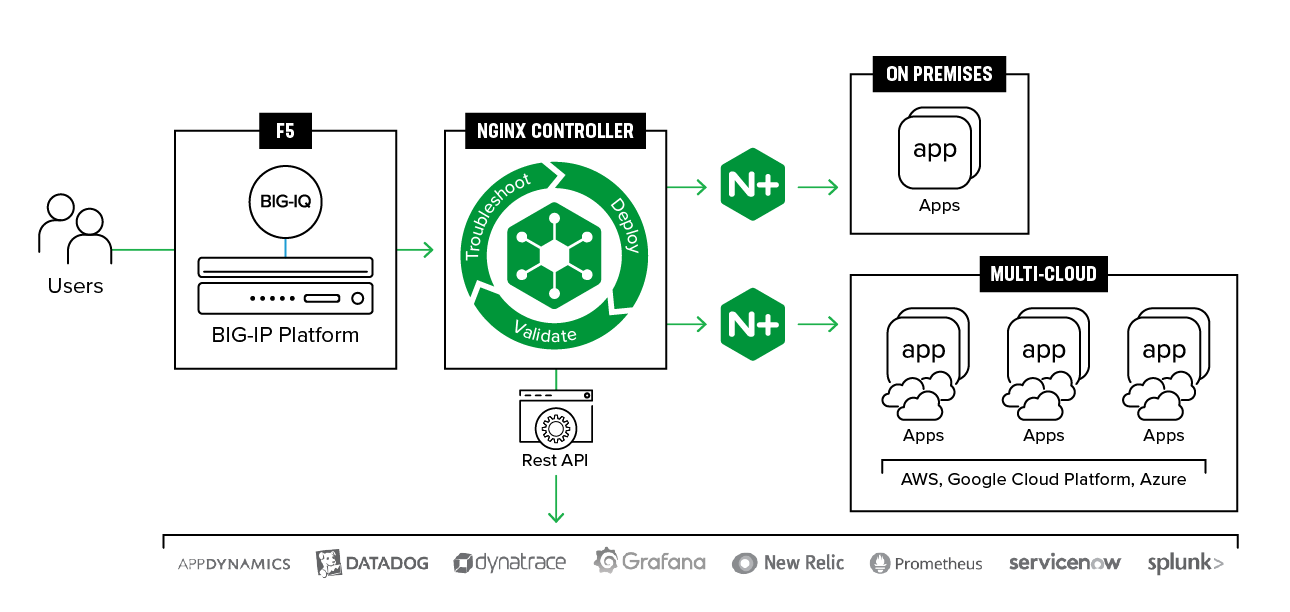Gain multi-cloud versatility with software load balancing designed for cloud-native apps
F5’s cloud-native ADC solution, NGINX, enables organizations to maintain consistent security and traffic management policies across clouds.
52% of organizations are changing how they develop applications in support of digital transformation1, and a multi-cloud strategy often plays a big role in that. For many organizations, it’s just not practical to be tied to one cloud anymore, given the flexibility of choosing the right cloud for each application.
As your app portfolio grows, though, so too do the security threats and performance risks. The more spread out your applications become, the more taxing and complex it is to manage consistent performance and load balancing policies across clouds.
To combat policy sprawl without impacting flexibility or speed, you need a lightweight policy management solution that spans across clouds. That means, in some cases, intentionally choosing not to adopt the native application services available on most public clouds. While these solutions may initially seem like the simplest option, they lack the advanced functionality and cross-cloud capabilities that a third-party solution will provide.
With the right policy management solution, you’ll give:
- App dev teams the ability to choose the right environment to host each application
- Networking and security teams the power to define and enforce critical security and traffic management policies consistently for all applications
F5’s NGINX Controller is a true software load balancer that is both lightweight and flexible. The NGINX load balancer, which can easily integrate into your existing automation toolchain, provides a control plane solution to define and manage configuration workloads for your NGINX load balancers. With this approach, your teams can create and deploy consistent security and performance policies across cloud platforms.
Using an intuitive GUI, NGINX Controller enables you to:
- Define configuration policies
- Reuse policies across different environments
- Ensure compliance against your policies
- Revert back to a “golden version” at any time, should you run into an issue
The architecture below illustrates that two is better than one: the BIG-IP platform at the edge supplies high-capacity security, decryption, and acceleration in a multi-tenant, consolidated footprint managed by BIG-IQ. Closer to the applications, NGINX Plus delivers single tenant, dedicated load balancing services for each app managed by the NGINX Controller.

Challenge
Most organizations prioritize cloud flexibility—and let application teams choose the best environment for each application—over the organizational benefits of common environments, processes, and tools. This leads to 87% of organizations supporting multiple clouds, selecting best-of-breed capabilities from each platform.
As applications proliferate, it becomes more challenging to implement consistent cross-cloud security, regulatory compliance, and application performance policies—and organizations rightly have concerns about long-term operability. In fact, as the size of the application portfolio grows, so does the threat landscape with bad actors targeting apparently inconsequential applications that tend to be poorly protected but offer a pathway into corporate data and other systems.
Solution
To reduce complexity and control costs, you can standardize on core application services (e.g., traffic management, application security) across cloud environments. By using the same software load balancing solution across multiple clouds, you achieve predictability in costs as well as consistency in app performance.
A policy-based approach to load balancing entails applying performance and security policies on a per-app or per-tenant basis. These app-specific policies can then be propagated across any cloud environment—as well as across any deployment environment such as development and production—thus eliminating irregularities in performance.
Learn more about NGINX Controller's Load Balancing Module. Read the data sheet.
Components
Designed for applications born and developed in the cloud, F5’s cloud-native ADC solution, NGINX, is a lightweight, flexible software load balancer that delivers high performance and multi-cloud versatility.
- NGINX Controller
NGINX Controller is NGINX’s control‑plane solution that manages the NGINX data plane. Built on a modular architecture, NGINX Controller enables you to manage the entire lifecycle of NGINX Plus, whether it’s deployed as a load balancer, API gateway, or a proxy in a service mesh environment. The Load Balancing Module configures, validates, and troubleshoots your NGINX load balancers. The API Management Module allows you to define, publish, secure, monitor, analyze APIs.
NGINX Controller ›
Conclusion
Multi-cloud is here to stay. If you want to maximize the benefits and minimize the risks, you need a cloud-native ADC solution to deliver consistent, high-quality application performance and security services in all your private and public cloud locations. F5 and NGINX are here to help.
Find out more about NGINX Controller by checking out this blog.
Accelerate digital transformation
Learn how NGINX can help you modernize your underlying IT and switch to a microservices approach.
Read the blog ›
Get an NGINX overview
Watch the video for a quick overview of NGINX Controller’s monitoring and alerting capabilities.
Watch the video ›
Find practical solutions
Download O’Reilly’s free eBook for a practical guide to load balancing services in the cloud.
Get the eBook ›
1 State of Application Services Report, DevOps Edition, 2019